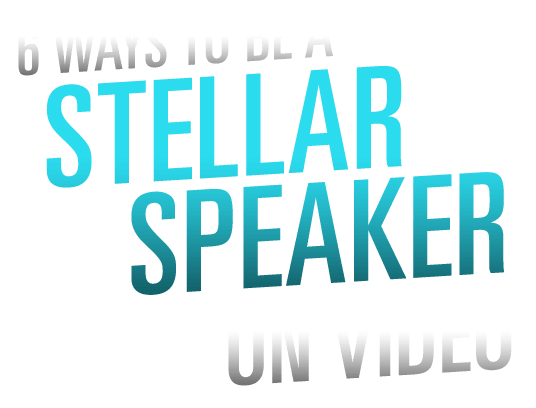Here Are 6 Ways to Be a Stellar Speaker on Video
Just as COVID-19 has thousands of people suddenly learning what it’s like to work remotely, speakers who are used to making the rounds of conferences, events, and trade shows are suddenly having to deliver their presentations in a very different setting: from home, on video, to an audience they can’t see.
For someone who’s used to the energy of a live crowd and the physicality of speaking on stage, making the switch to video or virtual presentations can be jarring. I feel grateful that I’ve been a physical keynote speaker as well as doing video for over a decade now.
No matter how great a speaker you are, the truth is that not everything that works on stage works online. In order to keep your audience’s attention, you’ll have to adapt your presentation style to its new format.
Here are seven ways to become a stellar speaker on video.
1. Shorten and compress your presentation.
One of the cardinal rules of video speaking is that your audience will not have the attention span that they would while watching you live. Not unless you are REALLY changing up angles and using a lot of props.
There are several reasons for shorter attention spans. For one thing, the people watching you don’t have additional stimuli to capture their attention when it wanders momentarily—the lights on the stage, other audience members, the rest of the room whose space you’re all sharing.
In order to keep your audience engaged, you’ll need to create a version of your speech that’s specifically designed for virtual presentation—shorter, more concise, and with more media and visual aids (we’ll get to this part in a moment).
Jay Baer’s “Webinine,” or a webinar that lasts only nine minutes, is a perfect example of this kind of adaptation. If your typical speech lasts an hour, create a 30-minute version, and even a 15-minute one that hits all the high points.
2. Add in multimedia aids.
Videos, images, screenshares, slides—these multimedia aids can be an excellent way to keep your audience’s attention throughout your speech.
A little goes a long way, so make sure that whatever additional content you use is deeply relevant to your topic and adds to your message, rather than distracts from or complicates it.
3. Speak directly to your audience.
One of the particular challenges of virtual speaking is not only building a connection with your audience, but helping them build a connection with each other.
A good—and surprisingly simple—way to initiate that connection between you and the audience is by addressing them as “you,” rather than in the third person (“everyone”). For example, saying “Can you see me?” rather than “Can everyone see me?”
If viewers are engaging in real time on social via live tweets, on Instagram or Facebook Live, or through another platform like Forbes8, you may be able to address questions or comments live, depending on how much attention you’re able to spare.
As for helping your audience build a connection with each other, there’s another simple language trick to use: remember to say “we.” Referring to yourself and the people who are watching you as a collective will help establish that sense of belonging to a group, and that’s powerful—even if it only lasts for the length of your presentation.
4. Plan and prepare just as much (or more) as you would for a live speaking event.
Planning and preparing are essential when it comes to being an excellent virtual speaker. Just like you wouldn’t go on stage without testing your sound and media, you shouldn’t show up online to a virtual engagement without having tested your software, sound, and visuals.
At least a day prior to your presentation, make sure you have the correct software downloaded, operating, and tested. That way, if something crashes or proves to be incompatible, you’ll still have time to switch providers and let your audience know about it.
5. Pay close attention to your background and sound.
Since you’ll likely be giving your virtual presentation from home as long as the coronavirus stay-at-home orders are in place, you’ll have to pay special attention to what your audience is seeing behind you. Piles of laundry, a stray dish, or a hallway that the other people in your household walk through can all distract from your message and make you appear less professional than you are.
And if your visual background is critical, your sound quality is even more so. Make sure your dog or cat is in a different room, that you won’t hear road or airplane noise where you are, and that you’ve got some kind of external microphone.
Even the tiny microphone on your earbuds will work better than simply speaking into your laptop mic.
6. Share information about your event widely once it’s over.
To keep your momentum going after your presentation is over, make sure to share widely about it on social media (which, incidentally, you should be doing with any live speaking events as well).
If you recorded your session, share video clips in the days afterward. You can also share some of the best questions, comments, or discussion points that came out of the speaking session.
Being a stellar speaker on video takes some practice, but there’s never been a better time to hone your skills. This challenging time is also an opportunity for those of us who can seize it. This could be your moment—don’t regret not making the most of it.










